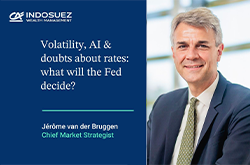Recovery Reality or Monetary Illusion? Are markets still too optimistic?

Monthly House View - July 2020 - Download here
A strong market acceleration has occurred since mid-May, with evidence of panic buying and short covering, and a violent rotation away from quality/momentum and into cyclical/value stocks.
Some may wonder if this movement is sustainable or exaggerated, and if it relies on firm ground or on unreasonable hopes.
Let us start with the positive side of the story and the three main arguments it relies on.
Firstly, the reopening of economies has started to reveal better than expected recovery patterns in the US. March market panic reflected the widespread recognition of a sharp recession in Q2, the symmetric rebound acceleration in May was synchronised with the easing of lockdown measures and in June with better than expected employment data and retail sales in the US. The rebound of oil prices has reduced the stress on producing countries and on the oil sector in the US.
Secondly, central banks have continued to intensify actions with an increase of the emergency asset purchase programme of the European Central Bank (ECB), and a stronger support provided by the US Federal Reserve to credit markets. This is expected to limit the magnitude of default rate increases.
Thirdly, governments continue to increase the magnitude of their fiscal action - it is true in Japan, which doubled the size of its plan; it is true in the US, with a USD 1 trillion spending plan on infrastructure; and it is true in Europe, which is currently in process of agreeing on a EUR 750 billion recovery plan including EUR 500 billion of grants. It seems to be true as well in China with could increase its macro support.
However, this positive narrative should not distract us from the challenges and significant uncertainties ahead of us. This is the less shiny side of the equation.
Where will the European unemployment rate be in one year? Will the emergence of a second wave of the COVID-19 infection in China lead to broader renewed lockdown measures? Are markets still too optimistic regarding the recovery of earnings and underestimating default rates?
What is certain is that the recent recovery of equity markets also reflect mechanical effects of monetary activism and the return of Fed Funds rate in to the ZIRP territory (zero interest rate policy). Lower rates warrant high present values for future earnings, and lower rates imply that equity prices rise if investors price companies on the back of a stable equity risk premium versus long-term rates. In a way, this mathematical evidence could be seen as a form of monetary illusion or as an actuarial artefact, which does not reflect the challenges around the prospect of net cash returns on equities and corporate bonds. If dividends and stock buy-backs are questioned and if corporate default rates are on the rise, investors should request higher risk premiums. As stocks continue to rise and spread tighten, the margin for error is getting thinner.
This could be one of the market themes around the Q2 earnings season, as a continued increase of markets and rotation into value would probably need to require a bottom-up confirmation at this stage.
Monthly House View, 17/06/2020 release - Excerpt of the Editorial
June 26, 2020




